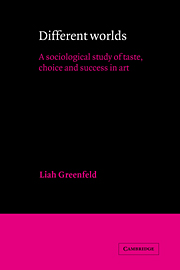Book contents
- Frontmatter
- Contents
- Introduction
- 1 Historical background
- 2 The population of painters and the split into subsystems
- 3 Patterns of success
- 4 The “gatekeepers” – critics
- 5 The “gatekeepers” – curators
- 6 The “gatekeepers” – gallery owners
- 7 The artists – attitudes of Conceptualists and Lyrical Abstractionists
- 8 The artists – attitudes of figurative painters
- 9 The publics
- 10 Conclusion
- Appendices
- Notes
- Index
- Titles in the series
9 - The publics
Published online by Cambridge University Press: 16 September 2009
- Frontmatter
- Contents
- Introduction
- 1 Historical background
- 2 The population of painters and the split into subsystems
- 3 Patterns of success
- 4 The “gatekeepers” – critics
- 5 The “gatekeepers” – curators
- 6 The “gatekeepers” – gallery owners
- 7 The artists – attitudes of Conceptualists and Lyrical Abstractionists
- 8 The artists – attitudes of figurative painters
- 9 The publics
- 10 Conclusion
- Appendices
- Notes
- Index
- Titles in the series
Summary
The discussion of the case so far might have already made clear, that the Israeli public is divided into two parts which correspond to the division of styles into figurative and Abstract and belong to the two subsystems of the Israeli art world. The division of the public is so conspicuous that one actually has to talk about two distinct publics.
According to the interviews, extracts from which will be quoted below, the main characteristic of the figurative art public is its self-confidence. This public has clear and rather well-founded personal preferences. Its members understand what they like and why. They approve or disapprove of paintings according to whether they answer their requirements or not. These requirements protect the public of figurative painting and help its members to explain why they prefer certain works of art or styles to the others. Since its judgment is based upon rational considerations, there is no intolerance towards the existence of those styles which this public does not accept. It does not perceive any threat in the existence of these styles and can allow itself to show patience towards them.
Although among this public there are persons who prefer “not quite Abstract and not quite Realistic” art, “real, but hinted, not finished things,” namely works of Impressionistic or Post-Impressionistic character, they, in any case, demand from the painter a demonstration of technical skill. In accordance with this, even paintings of this kind have to be “with some sense, not mere daubs”.
- Type
- Chapter
- Information
- Different WorldsA Sociological Study of Taste, Choice and Success in Art, pp. 146 - 160Publisher: Cambridge University PressPrint publication year: 1989

